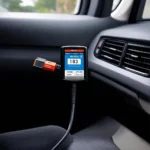Imagine this: you’re cruising down the Pacific Coast Highway in your sleek Audi A4, the California sun warming your face. Suddenly, your engine sputters, coughs, and dies. You pull over, heart sinking as you realize you’re stranded. A quick check under the hood tells you it might be a fuel pressure issue. But how can you be sure?
Enter the trusty scan tool, a mechanic’s best friend in the 21st century. This little device can unlock a treasure trove of information about your car’s health, including – you guessed it – fuel pressure.
Understanding the Importance of Fuel Pressure
Before we dive into the “how-to,” let’s understand why fuel pressure matters. Just like our bodies need blood pressure to function, our cars need the right amount of fuel pressure to run smoothly.
From a Mechanic’s Perspective: John Miller, a seasoned mechanic from Chicago, puts it simply: “Fuel pressure is the lifeblood of your engine. Too low, and your engine starves for fuel, leading to poor performance, misfires, and even stalling. Too high, and you risk damaging injectors and other components.”
The Technical Angle: Fuel pressure ensures the optimal air-fuel mixture in your engine’s combustion chamber. This delicate balance is crucial for efficient combustion, power delivery, and minimizing harmful emissions.
The Economic Impact: Ignoring fuel pressure problems can lead to costly repairs down the road. Regular checks with a scan tool can help identify and address issues early, saving you time, money, and potential headaches.
Demystifying the Scan Tool: How to Check Fuel Pressure
Now for the main event – using a scan tool to diagnose fuel pressure. Here’s a step-by-step guide:
-
Choose the Right Tool: Not all scan tools are created equal. Some basic models might not read fuel pressure, so ensure yours is compatible. For European cars like BMW, Mercedes, or Volkswagen, a dealer-level scan tool is highly recommended.
-
Connect and Power Up: Locate your car’s OBD-II port (usually under the dashboard on the driver’s side) and connect your scan tool. Turn the ignition to the “on” position without starting the engine.
-
Navigate to Fuel Pressure Readings: Scan tools differ in their interfaces, but most will have a dedicated section for “Engine Data” or “Live Data.” Navigate through the menus to find “Fuel Pressure.”
-
Interpret the Readings: Compare the displayed fuel pressure to your car manufacturer’s specifications, which can be found in your owner’s manual or online.
-
Analyze and Diagnose:
- Low Fuel Pressure: This could indicate a clogged fuel filter, weak fuel pump, faulty pressure regulator, or even a leak in the fuel lines.
- High Fuel Pressure: A likely culprit is a malfunctioning fuel pressure regulator or a blockage in the return line.
Common Questions About Scan Tools and Fuel Pressure:
Q: Can I use any OBD code reader to check fuel pressure?
A: Not necessarily. Many basic code readers only show generic fault codes. You’ll likely need a more advanced scan tool that can read live data from your car’s ECU (Engine Control Unit).
Q: My scan tool shows a fuel pressure reading, but my car still runs poorly. What’s wrong?
A: While the reading might seem within range, other factors could be at play, such as a faulty fuel pressure sensor, injector problems, or even electrical issues. Further diagnosis is needed.
Q: I’m not comfortable working on my car. Can I still use a scan tool?
A: Absolutely! A scan tool can be a valuable tool for informed decision-making. Even if you’re not doing the repairs yourself, knowing the potential issue beforehand can help you communicate effectively with your mechanic and avoid unnecessary guesswork.
More Than Just Fuel Pressure: Unlocking Your Car’s Secrets
Remember, a scan tool is a versatile tool that can help you diagnose a wide range of car problems. From checking engine temperature and oxygen sensor readings to monitoring transmission performance and emissions systems, the possibilities are vast.
Need Help? We’re Just a Message Away!
Diagnosing car problems can be daunting, but it doesn’t have to be. If you need assistance using your scan tool or interpreting those cryptic error codes, our team of automotive experts is here to help. Contact us on WhatsApp at +84767531508 for 24/7 support. We’re always happy to lend a helping hand and get you back on the road!
Keep Exploring:
- [Common OBD-II Codes and What They Mean](link to relevant article)
- [Top 5 Scan Tools for DIY Mechanics](link to relevant article)
- [Understanding Your Car’s Electrical System](link to relevant article)



